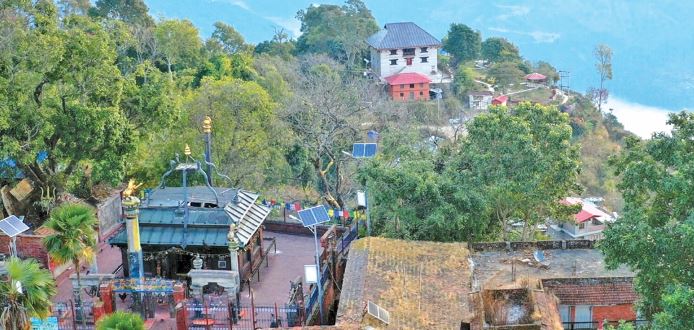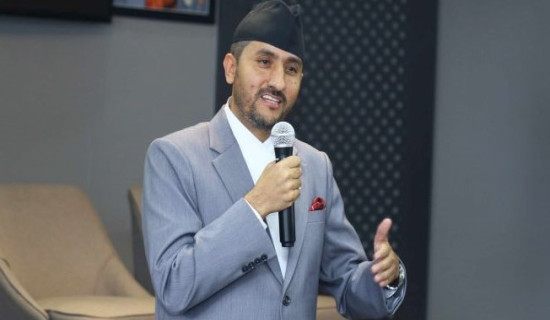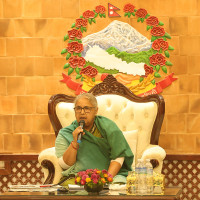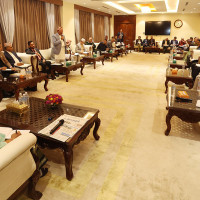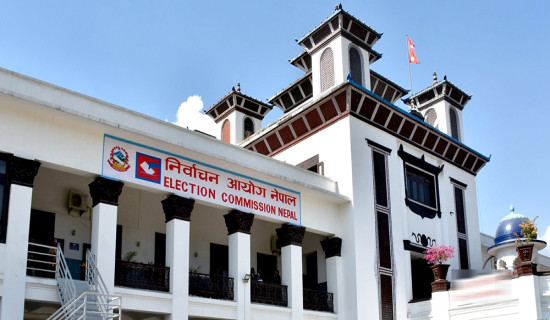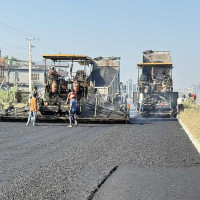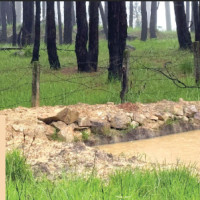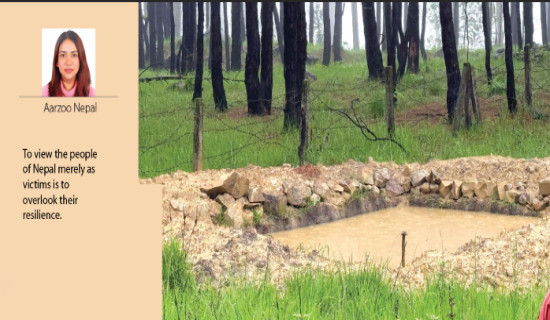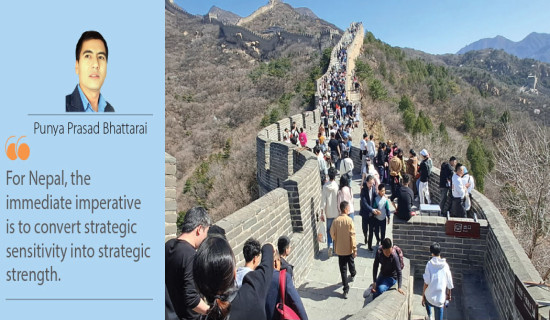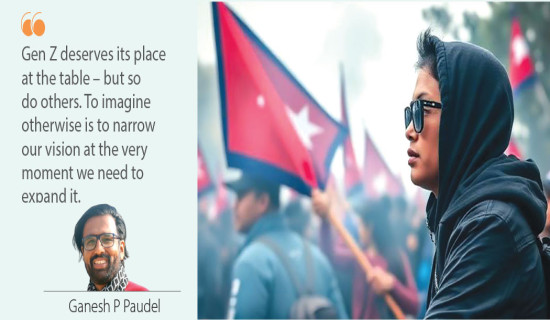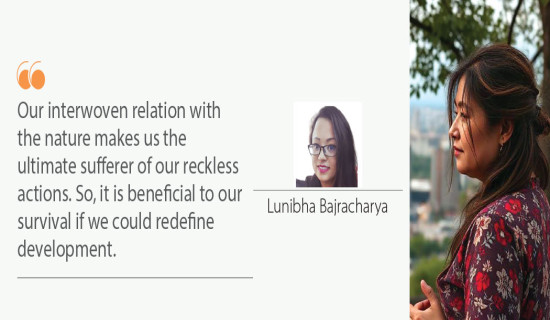- Saturday, 6 December 2025
Mystery of Tripurasundari Temple
Prof. Dr. Shyam Joshi
As mentioned in Hindu sacred books Goddess Tripurasundari has three forms: Tripura Bala, Tripura Sundari, and Tripura Bhairavi. Tripura Bala is a young virgin goddess, Tripura Bhairavi is the terrible power of the Goddess Lalita, and the third form Tripura Sundari is a marvelous eternal beauty of the three worlds.
The legend is that Goddess Tripurasundari was created to protect the people on earth and in heaven by killing the demon Bhandasura. She is a blending of compassion, grace, and beauty. People believe that they can get relief from various problems they encounter in their daily life by the blessings of Tripurasundari. She helps them attain salvation in their lives.
Tripurasundari temple in Dolakha
Tripurasundari Bhagawati is one of the prominent deities of the historical town Dolakha too. The three-storied building - shaped temple of goddess Tripurasundari lies to the east of Bhimeswor temple outside a forest. The premise of the goddess is known as Devikot since in past social leaders of the town used to assemble in the courtyard of the temple while making delicate decisions or giving judgement on major disputes.
No one known the exact date when the temple was built. The legend is that three devis, while they were taking bath in river Tamakoshi, were seen by two tantric brothers of Dolakha. Two brothers identifying them as goddess persuaded to reside in Dolakha.
Among the three sisters Kalinchowk Bhagawati, Tripurasundari and Bal Kumari, Tripurasundari, the eldest of them, agreed to reside in the current location Champuja area overlooking river Tamakoshi. From current location one can enjoy the spectacular view of river Tamakoshi flowing like a curling giant snake.
It might not be mere coincidence that the temples of these three deities have one thing in common - they do not have any idol of goddess. People worship and pay homage on a water pit known as “Jal kund” in the temple of Kalinchowk Bhagawati. Bal Kumari temple, where nobody except those with dikshya are allowed to enter, has neither a temple as such nor any image of goddess except an iron chain tied to the ground as said by those who have access to the spot. Likewise, in Tripurasundari temple devotees worship and pay homage only on the door of the room in which the goddess is presumed to reside and are not allowed to enter the room.

Newly reconstructed temple of goddess Tripurasundari
The legends linking this temple to Swasthani and Mahabharat indicate that the temple is very ancient indeed. Linked to Swasthani legend says that the left knee of Satidevi fell in Devikot of Dolakha. Likewise, linked to Mahabharat the legend is that Pandavas prayed Tripueasundari to suggest a secret place for Guptabas to hide themselves, and the goddess suggested them to go and work in the palace of the king of Birat to remain unnoticed.
Legends aside, according to Y. K. Pradhan, writer of the book “Cultural Heritage of Dolakha” there is written evidence in the form of Thyasapu that the temple was renovated in 1759 B.S. This clearly indicates that the temple was established much earlier than 1759 B.S. there is also an evidence that King Girbanyuddha Bikram Shah had given order to make proper provision for the day-to-day worship and conduct other rituals and festivals linked to the temple in 1860 B.S. This temple has been reconstructed in same old design after the great earthquake of 2072 B.S.
Mystery of Temple
Unlike the temple of other places Tripurasundari temple is a simple three-storied house. Nobody except the priest is allowed to enter the room where the image of the goddess is said to have been placed. Devi’s room lies in the south-west part of the second floor. Outside this room in the front side of the temple there is a large artistic window with three parts. Nobody sits in the southern part of the window in the belief that the goddess sits there to view outside. The devotees pay homage to the goddess and keep offerings including “bheti” on the door of the room of the goddess. Even the priest does not disclose the secret of the room where the image of the goddess has been kept.
In past the priest of the temple used to be selected by lot by a virgin girl from among the upper caste or “Chha thari” Newars of Dolakha with religious education or Dikshya. After selection he used to be the priest until his death. The priest continues the daily puja of Bhagabati without interruption even if his own family member dies. He continues puja without mourning the death of his family members. The basement of the temple is called “Ghost Room”, and nobody ventures to enter that room. Only in Khadga Jatra festival the commander of the gods’ army known as Yakargan enters the room to slay the demons hiding there.
In Bada Dasai and Chaite Dasain this temple also gets puja materials including goats and buffalo for sacrifice as prevailing ritual from Bhimeswor guthi. The naibedya of the temple is also typical comprising beaten rice, meat, and special type of rice beer called “Kaata”.
There is the provision of Guthi lands for the regular puja of the goddess. People of Dolakha particularly on the day of Sitinakhat and Maghe Sakranti do not eat their feast without worshipping the goddess and setting aside the feast to the deities of Dolakha including Tripurasundari. Hence in these festivals people of Dolakha make a crowd in this temple.
People who want their wishes fulfilled make promise (Bhakal) to the goddess to worship with goat sacrifice if their wishes are fulfilled. People worship the goddess to get rid of various problems like delay in marriage, lack of child, litigation, poverty, promotion in job and get blessings by worshiping her. The priest worships the goddess and sacrifices the goat alone however big it might be alone on behalf of the worshipper.
The person who worships the goddess keeps an screen in the door of the room of the goddess as the symbol of their worship. Traditionally people who perform Bhakal puja should invite their relatives and friends for feast at the premise of the goddess and are not invited to their houses. Since Tripurasundari temple is sacred to both Hindus and Buddhists, they worship and pay homage to goddess Tripurasundari with great devotion without any prejudice.
Festival of sword
The power of Goddess Tripurasundari is reflected in the famous Khadga Jatra Festival of Dolakha which is celebrated every year on occasion of Durga Puja or Bada Dasai, Bada Dasain is the greatest festival of Nepali people. On the eve of Bada Dasai on the day of Ekadashi “Khadga Jatra” (sword festival) takes place centered around this goddess. First, on the day of Dasami (day of Tika) Thami ethnic group plays important role in this festival who first purify themselves by eating fire, then they slay the demon and drink the blood. Buffalo represents the demon. After that they go to other parts of the town and slay other demons.
On the day of Ekadashi (last day of Bijaya Dashami) procession pertaining to war of the gods against demon Mahikhasur begins from Rajkuleswor of Dolakha early in the morning. By killing many soldiers of the demon side even by taking the help of Bal Kumari in Pingal toal Yakargan, the commander of the soldiers of the gods, go to Tripurasundari and pray for the help to slay Mahikhasur. The goddess accepts the request, gives blessing to them with tika and sends her own son Bhatingkhara to help slay the demon. The goddess also accompanies them to observe and encourage her son in the guise of pujari. From the temple Bhatingkhara replaces Yakargan as the commander and eventually succeeds in killing Mahikhasur in the place called Chherpwale (place where the demon is beheaded).
In Nepal the temple of goddess Tripura Sundari can be seen even in places like Kathmandu, Bhaktapur, Dhading, Baitadi, Dolpa and Tauthali of Sindhupalanchok district. The rituals of worship might vary from place to place. Tripurasundari temples are located also in many places of India like Banswara of Rajasthan, Udaipur of Tripura, Manali of Himachal Pradesh, Mysore and Karnataka,
How to get there
Dolakha town historically known as Abhayapur is 134 km from Kathmandu and can be reached in 6 hours in local bus and 4 hours in private car and jeep. Many restaurants, hotels and lodges are easily available in Dolakha now in affordable price. There are many travel agencies conducting package tour of Bhimeswor and Kalinchowk Bhagawati temples. It is better for the pilgrims to Bhimeswor temple to visit Tripurasundari temple as well since besides Darshan of these deities they can also have the spectacular view of River Tamakoshi and Mt. Gaurishankar from nearby Champuja park. The pilgrimage to the holy land Dolakha on the day of Yakadashi of Bada Dasai offers double benefits of having darshan of two deities and a fantastic opportunity to observe a day - long unique Festival of Sword (Khadga Jatra). End
(The author is an expert on Nepali culture )

